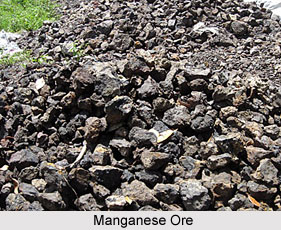 Manganese ore is produced in huge quantity in India. Rather, it can be said that this country is one of the chief producers of manganese ore in the world. Manganese ore is principally used in the manufacture of ferro-manganese and steel. Moreover, it is also used in small quantities in paint and glass. In dry cell batteries, manganese dioxide is used. The annual production of manganese ore is huge and it ranges enormously. Manganese ore is basically mined in Madhya Pradesh, Andhra Pradesh, Orissa, Maharashtra and Karnataka.
Manganese ore is produced in huge quantity in India. Rather, it can be said that this country is one of the chief producers of manganese ore in the world. Manganese ore is principally used in the manufacture of ferro-manganese and steel. Moreover, it is also used in small quantities in paint and glass. In dry cell batteries, manganese dioxide is used. The annual production of manganese ore is huge and it ranges enormously. Manganese ore is basically mined in Madhya Pradesh, Andhra Pradesh, Orissa, Maharashtra and Karnataka.
Though the manganese ore occurs at different places in the Indian Plateau, but it is found in large quantities in Bhandara, Nagpur and Balaghat districts. These places are situated close to each other in the central and western regions of the country. Of the total manganese ore reserves in the country, Balaghat-Nagpur-Bhandara manganese belt accounts for a huge portion. Orissa is considered as the leading producer of manganese ore in the country. In this state, manganese ore is mainly mined in Keonjhar and Sundargarh districts. These two districts are leading manganese ore producers with huge tonnes of production. After Orissa, Karnataka is the second leading producers of manganese ore in the country. Here, manganese ore is mainly mined in Bellary District, Shimoga and North Kanara districts. Further, Nagpur and Bhandara districts of Maharashtra, Balaghat district of Madhya Pradesh are other important places where manganese ore is mined. It is also mined in Adilabad District and Vizianagaram District of Andhra Pradesh.
Interestingly, the consumption of manganese ore has significantly increased in the country over the past few decades. It increased owing to the increasing use in making steel and ferro-manganese. Moreover, dry cell batteries that are also manufactured in India consume some proportion of manganese dioxide. As a result of the limited domestic needs, almost more than half of the total manganese ore mined in India is exported to some of the industrially advanced countries. Thus, the production of manganese ore depends on foreign demand to a large extent as it is basically mined for export purpose. Initially, near about half of the value of all the Indian mineral resources and ores exported was shared by manganese ore. However, at times share of the value of export of iron ore has increased pushing manganese ore in the second position.
In India, though there are large deposits of manganese ore, still the country has not been able to increase the export rate of this ore.



















